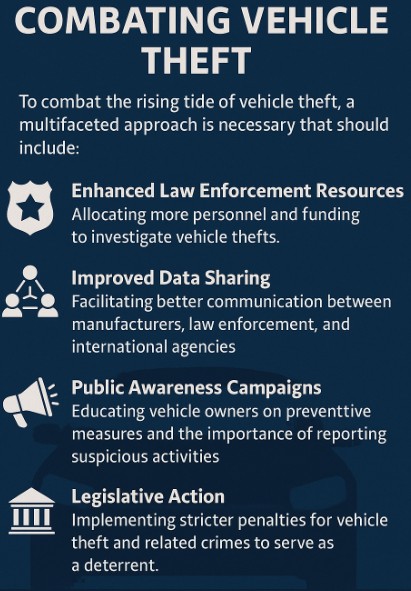Vehicle taking allegations in the United Kingdom hve surged in recent years, reaching a 15-year high with 129,159 vehicles stolen between April 2023 and March 2024 . This alarming trend has sparked debates over the root causes, with some attributing the rise to manufacturers’ security shortcomings. However, is the primary issue not attributable to vehicle design but in systemic failures within law enforcement and governmental prioritisation?
- ‘an average of 356 vehicles* being taken every day of the year’.
- ‘just 2.2% of all car thefts result in criminal charges’**
- ‘we would like to see the re-establishing the vehicle theft taskforce that was set up in 2019’
*’vehicles’ – not just cars but comprising mopeds to HGV’s – more vehicle taking figures are available here.
**’just 4% of car thefts resulted in a suspect being charged or summonsed – Lib Dems (2023)
Law Enforcement’s Diminishing Role
The effectiveness of police response to vehicle theft has markedly declined. In England and Wales, approximately 85% of vehicle-related crimes are closed without identifying a suspect, with some investigations terminated in under 24 hours . The Metropolitan Police Service reported a mere 0.9% detection rate for vehicle offences in 2022/2023 . Such statistics underscore a significant reduction in investigative efforts and a growing perception of vehicle theft as a low-priority crime
- ‘Police in England and Wales fail to catch any car thieves in 100 neighbourhoods’ – Guardian 03/2024
- ‘Police facing a spate of keyless car thefts in many neighbourhoods are closing some cases in less than 24 hours even when CCTV footage is available‘ (Guardian 2024)
- ‘police needed better training to detect the sophisticated technology often used in car crime‘.
The Risk-Reward Imbalance
The current landscape presents a favourable risk-reward scenario for criminals. The low likelihood of apprehension, coupled with the high value of stolen vehicles and parts, incentivizes theft. Stolen vehicles are often dismantled for parts or exported, feeding a lucrative black market. The minimal risk of prosecution emboldens offenders, perpetuating the cycle of crime.
Manufacturers: Not the Primary Culprit
While advancements in vehicle technology, such as keyless entry systems, have introduced new vulnerabilities, it is unjust to place the onus solely on manufacturers. Automakers have implemented security measures, but the rapid evolution of criminal tactics often outpaces these efforts. Moreover, the lack of robust law enforcement response diminishes the deterrent effect of technological safeguards.
Understanding the Motivations Behind Vehicle Theft
Several factors contribute to the prevalence of vehicle theft:
- Organized Crime: Sophisticated networks target vehicles for resale, exchange or parts distribution locally or aboard – seemingly perceiving the crime as straightforward, low risk, high reward. Criminals use stolen vehicles in other illegal enterprises, such as drug trafficking and robbery
- Economic Factors: Financial hardship can drive individuals toward organised & opportunistic theft.
- Joyriding: Individuals, often youths, steal vehicles for thrill-seeking purposes – arguably less so given the introduction of the immobiliser/transponder keys some 30 years ago.
Then there are:
- Fraudulent Activities:
- Obtaining of vehicle by fraud – the benefits often being that the car keys are handed over and the crime not discovered for days, weeks or possibly more
- False allegations of taking – to dispose of a financial liability or to distance oneself form a vehicle involved in a crime or RTC. This issue appearing to be of little or no interest to law enforcement
These motivations are exacerbated by the perceived low risk of detection and punishment.
Recommendations for Addressing the Crisis
To combat the rising tide of vehicle theft, a multifaceted approach is necessary that should include:
- Enhanced Law Enforcement Resources: Allocating more personnel and funding to investigate vehicle thefts.
- Improved Data Sharing: Facilitating better communication between manufacturers, law enforcement, and international agencies.
- Public Awareness Campaigns: Educating vehicle owners on preventive measures and the importance of reporting suspicious activities.
- Legislative Action: Implementing stricter penalties for vehicle theft and related crimes to serve as a deterrent.
Conclusion
The surge in vehicle theft across the UK is less a reflection of manufacturing flaws and more indicative of systemic issues within law enforcement and governmental prioritization. Addressing this crisis requires a concerted effort to bolster investigative capabilities, enhance inter-agency collaboration, and implement policies that deter criminal activity. Only through such comprehensive measures can the trend of vehicle theft be reversed, ensuring greater security for vehicle owners nationwide.
Most feelgood stories about vehicle taking events tend to centre upon discovering ‘stolen’ vehicles (not always in ‘as was’ condition). But recovery rates are difficult to come by, seemingly relatively low.
What of deterrents?
